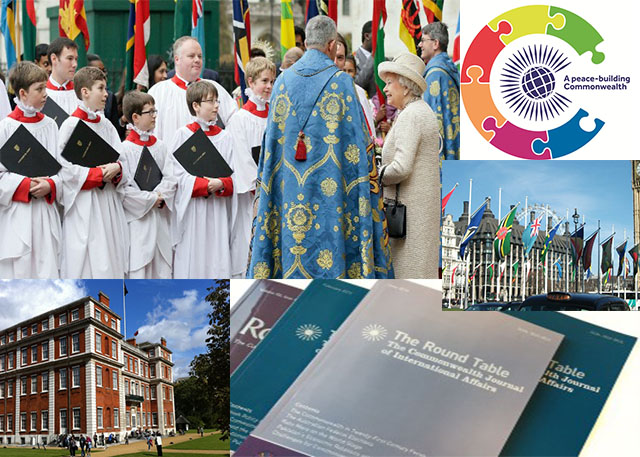 A look back through the archives of the Round Table Journal
A look back through the archives of the Round Table Journal
[Round Table spoke with Sir Peter Marshall about the role of Commonwealth Day in 2017. In part one, he writes about the move to a shared date.]
The Commonwealth is quite unlike any other significant international organisation.
Difficult as it may be in the case of most such bodies to define what they are, as distinct from describing what they do, the task in the case of the Commonwealth is almost insuperable. So some amplification of that proposition can serve as a collective introduction to the Round Table’s questions about the meaning of Commonwealth Day in 2017.
Fundamentally, the Commonwealth is the imaginative realisation – in both common meanings if the word – of the advantages of continuing to cherish together values held in common and to maintain links of all kinds – when political circumstances change. In this 500th anniversary year of the Reformation, it is worth recalling that the case for adopting such a policy is articulated with consummate tact and grace in the Preface to The Book of Common Prayer. It is likewise very well illustrated by the words and actions of the Founding Fathers of the United States, whose wisdom and moderation compare so favourably with the bone-headedness of their oppressors in London.
It came easily for the “countries of settlement” – Canada, Australia and New Zealand. It was more problematic in the case of South Africa. The erection in 2007 of a statue of Nelson Mandela in Parliament Square is fitting testimony to the unparalleled magnanimity and statesmanship of an exceptional personality and the receptiveness and collective persistence of a unique international association.
In institutional terms, the Great Leap Forward owes its inspiration to Jahawarlal Nehru, the first Prime Minister of India and prominent world statesman of the mid-twentieth century. At a specially convened meeting of Commonwealth Prime Ministers in 1949 in London, he sought the agreement of his colleagues to India remaining in the Commonwealth after it became a republic, and so being unable to satisfy what was then the essential requirement of membership, namely allegiance to the Crown. Not only did he see this as in India’s interest. His view was also that the Commonwealth could bring “a touch of healing to a troubled world”.
The formula devised at that meeting to meet Nehru’s request – the London Declaration – is contained in a four-paragraph communique of exceptional clarity and ingenuity. The flexibility which it embodied is the key to the evolution of the modern Commonwealth.
Again in an institutional sense, the Imaginative Realisation evolved slowly. It was not until 1965 that the Commonwealth Secretariat was established, the British Government having continued meanwhile to provide such common services as were thought necessary. On the other hand, meetings of Commonwealth Heads of Government (CHOGM) in London had become a regular and frequent feature. The question of prospective British membership of the EEC (in the event delayed by a decade, thanks to two de Gaulle vetoes) was a matter of prime concern.
In an historical perspective, however, the key aspect of these gatherings was assuredly the ready attendance of so many pioneers of independence, of whom a significant number had seen the inside of a British or colonial goal.
The Commonwealth flourished in both its official and in its non-governmental activities, as befits an association not only of governments, but very much also of peoples.
Heads of Government, at their regular biennial meetings (as they had become by the 1970’s) issued a number of Declarations about Commonwealth priorities and purposes, notably at Singapore in 1971, and at Harare in 1991.
But it was still the case that there was no general, let alone comprehensive statement of the identity of the Commonwealth. We relied rather on general propositions such as “the Commonwealth is a force for good” and “Commonwealth is as Commonwealth does”.
It was not until 2009, the 60th anniversary of the London Declaration, that Commonwealth Heads of Government at their regular meeting in Trinidad and Tobago that year, established an Eminent Persons’ Group (EPG) – no empty phrase, in the event – to undertake “an examination of options for reform in order to bring the Commonwealth’s many institutions into a stronger and more effective framework of co-operation and partnership”. The report which the EPG compiled was highly relevant, competent and detailed. It contained no less than 106 recommendations, covering a massive range of topics. Time did not permit an adequate examination of the report at the Perth CHOGM in 2011. The 2013 CHOGM in Sri Lanka was grievously overshadowed by acute political difficulties in the host country.
In the meantime, the great majority of the EPG’s recommendations had by then been implemented by the Secretariat. Commonwealth Governments also agreed to establish a Commonwealth Charter, as recommended by the EPG, ‘after the widest possible consultation in every Commonwealth country’. The Charter was signed by The Queen on behalf of us all on Commonwealth Day 2013.
The putting down of deeper analytical and administrative roots complemented the rising consciousness of the scope held out by the twenty-first century for which, as Kamalesh Sharma, the previous Secretary-General put it, the Commonwealth was tailor-made”.
The Commonwealth Games in Glasgow in July/August 2014, on the eve of the centenary of the outbreak of the Great War, were a great success.
There was overall a real sense of build-up to the CHOGM in Malta in 2015, the 50th anniversary of the establishment of the Commonwealth Secretariat.
Sir Peter Marshall is a former Commonwealth Deputy Secretary-General. He has also served with the Foreign & Commonwealth Office and as Britain’s Representative to the United Nations. He has also served as the Chair of the Royal Commonwealth Society.



